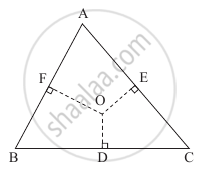Advertisements
Advertisements
Question
Using vector method, prove that the perpendicular bisectors of sides of a triangle are concurrent.
Solution

Let D, E, F be the midpoints of the sides BC, CA and AB of ΔABC.
Let the perpendicular bisectors of the sides BC and AC meet each other in the point O.
Choose O as the origin and let `bara, barb, barc, bard, bare` and `barf` be the position vectors of the points A, B, C, D, E, F respectively.
Here, we have to prove that `bar(OF) = barf` is perpendicular to `bar(AB) = barb - bara`.
By the midpoint formula
`bard = (barb + barc)/2, bare = (barc + bara)/2, barf = (bara + barb)/2`
Now, `bar(OD) = bard` is perpendicular to `bar(BC) = barc - barb`
∴ `bard*(barc - barb)` = 0
∴ `(barb + barc)/2*(barc - barb)` = 0
∴ `(barc + barb)*(barc - barb)` = 0
∴ `barc*barc + barb*barc - barc*barb - barb*barb` = 0
∴ c2 – b2 = 0 ...`[∵ barc*barc = c^2, barb*barb = b^2 and barc*barb = barb*barc]`
∴ c2 = b2 ...(1)
Also, `bar(OE) = bare` is perpendicular to `bar(AC) = barc - bara`
∴ `bare*(barc - bara)` = 0
∴ `(barc + bara)/2*(barc - bara)` = 0
∴ As above c2 = a2 ...(2)
∴ From (1) and (2), we get
b2 = a2
∴ b2 – a2 = 0
∴ `(barb + bara)*(barb - bara)` = 0
∴ `(barb + bara)/2*(barb - bara)` = 0
∴ `barf*(barb - bara)` = 0
∴ `barf = bar(OF)` is perpendicular to `barb - bara = bar(AB)`
Hence, the perpendicular bisectors of the sides of ΔABC are concurrent.
